|
The Parker Nitefly Mojo - A Technical Analysis
Last Updated 7/26/06
By Paul J. Marossy
I just bought this guitar on 8/12/05. I had wanted one of these for several years now, and I finally just bit the bullet and bought one.
The first time that I played the Parker Fly was in 1998 at a local music store, and I wanted to buy it immediately (but I had some self-control). Now that I actually own one, after
playing it for a few days, I have come to really appreciate the design of this guitar and all of the technological improvements of this guitar over the conventional electric guitars
like the Stratocaster, Les Paul and other well known instruments. And that is what led me to write this article - I thought it deserved some closer attention from a technological
standpoint.
Most of the history of the Parker Fly has been told, but what most people don't know is that the basic design of the guitar had been kicked around from the early 1980s,
and hasn't changed too much from
the original prototype
made around 1985 and its introduction to the world in 1993. Of course, like every other guitar manufacturer, Parker Guitars has
been striving to improve its current offerings as well as introducing new models. It looks like Parker Guitars is here to stay.
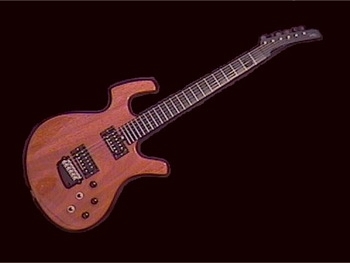 |
The first
thing that strikes you about the guitar is the radical design. Kind of like a space
age Stratocaster, in a cool way. This particular model is the Parker Nitefly Mojo,
with a one piece mahogany body and carbon fiber covered 22 fret mahagony neck. It only
weighs about 6 lbs.
|
 |
Here is a little closer view of the body. It has a six element Fishman piezo pickup on the bridge and a Seymour
Duncan JB at the bridge, and a Seymour Duncan Jazz pickup at the neck. Both humbuckers have a coil tap. There is
one volume control for the magnetic pickups, and a seperate volume control for the piezo pickup. The tone control
is common to both pickup systems, and the piezo pickup & magnetic pickups can be used in any combinaton. This
can yield some cool sounds, and the piezo on the bridge can get you a cool acoustic vibe. |
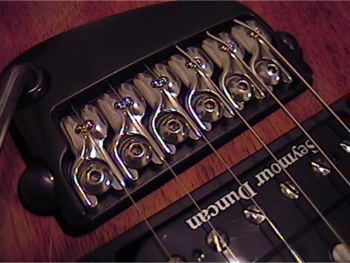 |
The Parker designed vibrato bridge is one feature that is really slick. It pivots on ball
bearings and has little rollers for each string. It is easily the best vibrato system I have ever used.
The "radius" of the bridge exactly follows the "radius" of the fretboard. It is possible to get the action
down quite low with this system. The other feature I like much more than the Floyd Rose type bridge is
that adjusting the intonation is a snap with the offset saddles - a very slick idea. It is much, much
easier to adjust the intonation on this guitar than any Floyd Rose locking "tremolo".
|
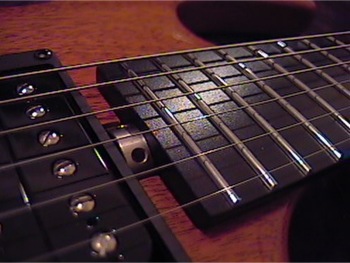 |
Another feature that I really like about the Parker Fly guitars is the carbon fiber fretboard with
stainless steel frets. Not only will it wear very well, but it also plays better than any electric that
I have owned thus far. Stainless steel frets are generally not recommended by most guitar builders because
they sound very bright, but on this guitar, they work very well. Adjusting the truss rod is also easier than any
other guitar I have ever owned. These are just a couple of the many innovative features of this model. |
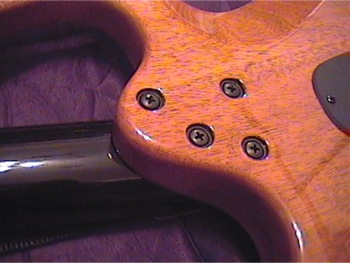 |
This is a bolt-on neck, with a neck joint that looks very similar to the ones used by Ibanez on their
S-Series guitars. But the similarity stops there. |
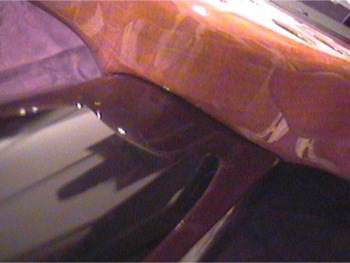 |
Another innovative feature of the Mojo is the neck joint - a radiused pocket. This holds the
neck solidly in place and prevents it from moving at all, creating a very stable neck joint for a bolt-on neck. |
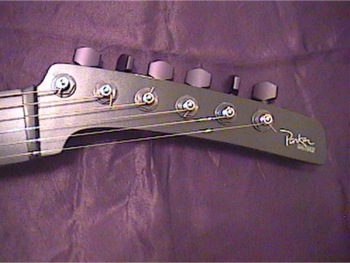 |
The headstock is just cool. If it weren't for the neck being covered with carbon fiber, I would be nervous
about getting broken. |
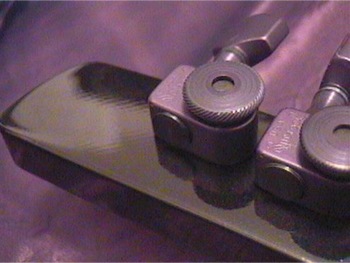 |
Here is the back of the headstock showing the Sperzel tuners. If you look close at the finish, you can
see a hint of the carbon fiber wrap towards the end of the headstock. |
 |
Here is a view of the back of the body. The cover is kind of funky shaped, but functional. The bridge
height can easily be adjusted from the back of the guitar through two access holes in the cover. There is also an
adjustable stop which will make the bridge work in fixed, bend-down only or in a floating position. |
 |
These are the springs for the Parker designed die cast aluminum vibrato. It uses only three springs as opposed
to the up to five required for the conventional Floyd Rose vibrato. Note that the cavity is painted black. Just another
little thing showing the attention of Parker Guitars to detail. |
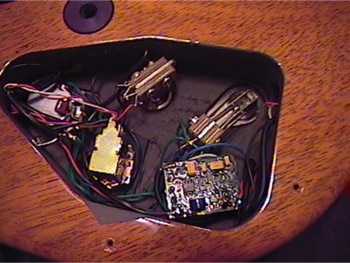 |
This a view of the control cavity. It is also coated with the same conductive paint. The interior of the back
cover is also coated with conductive paint. It's pretty effective as this guitar has the quietest single coil pickups
I have ever heard! The little PCB contains the electronics for the Fishman piezo pickup system. |
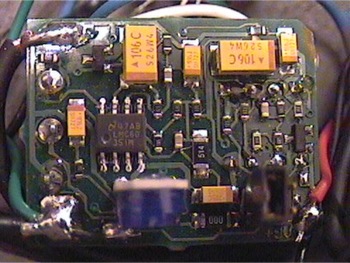 |
This is a closer view of the PCB. It uses Surface Mount Technology (SMT) which enables it to be quite compact -
barely bigger than the back of the pot that it is mounted to. The blue trimpot sets the overall level of the piezo
pickup system. This board is made by Fishman, and is called a "PowerChip". You can buy these directly from
Fishman Electronics. |
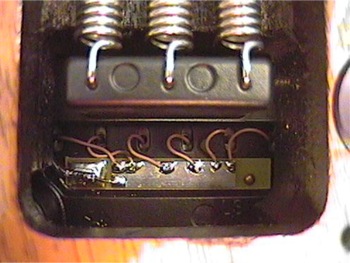 |
This is the six element piezo pickup system on the underside of the bridge. |
 |
The jack is a special "smart jack" that knows what to do based on what kind of cord you plug into it. With a
special stereo to mono Y-cord, you can send a stereo signal to a pair of amps. One can be dedicated to the magnetic
pickups and the other one can be dedicated to the piezo pickup system. |
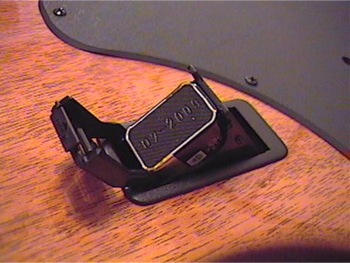 |
Even the battery holder is darn clever. It just flips up and you stick a battery in it
and then you snap it shut. And, no covers that can get lost. My
only complaint with the battery holder is that part of it cracked after I had the guitar for about 10 months. That
resulted in a totally dead guitar because the battery was not making a good connection with the contacts on the battery holder, but
I found the problem and repaired it. The solution was quite simple: I just bent the contacts a little bit to make a more snug connection
with the battery. The battery holder is glued into the body, so removing it and replacing it would be difficult.
|
As Parker Guitars claims, I have to agree that this really is the most advanced electric guitar on the market today.
They are built with amazing precision and the quality of the finish is impeccable. The Mojo series is one of the best offerings yet from Parker guitars, and with great
tones & playability, it's a winner in my book.
Stereo Splitter Box
Eliminating Crackling Switches
Parker Guitars Website
My Home Page
|














